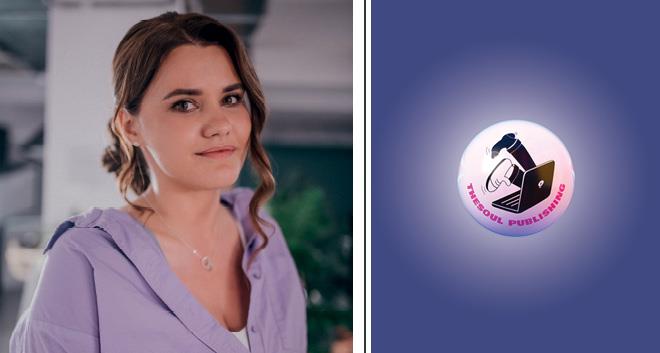In recent years, digital media powerhouse TheSoul Publishing has added long-form production to its successful short-form content, such as the comedy cartoon show that follows the surreal adventures of an avocado couple. It has also entered the music industry with a digital anthropomorphic pop artist that brings to mind Japanese anime. Here, the company’s new Chief Creative Officer, Anastasiia Vinogradova, talks about content production, studying trends and the universality of music.
What does your role as Chief Creative Officer entail?
I lead creative teams based in our three studios in Europe and those who work remotely across 70 countries around the globe. I am responsible for overseeing the strategy and execution of all creative goals. I supervise creative production, leading innovation, and the ongoing design of our high-performing creative ecosystem, to achieve the company’s goals.
How did your involvement in the entertainment business come about?
I started in the marketing department of an online university and eventually switched to product ownership. Prior to joining TheSoul Publishing, I had built several projects in online education, as well as EdTech products, and gained relevant experience in content production. It was always important to me to design highly engaging learning experiences, where people will not only work toward their goals but also enjoy the process of learning. In 2016, I moved from edutainment to the entertainment business when I was invited to join a company that was pioneering in the digital media business with the goal of building creative productions from scratch. Building creative teams capable of creating high quality, entertaining, and positive content has turned out to be quite fulfilling and I have continued down this path at TheSoul.
TheSoul Publishing has a number of channels, each producing different content. So, I have to assume that you are dealing with an endless stream of ideas. Does it ever get too abstract or even chaotic at times? How do you manage?
TheSoul Publishing has more than 100 channels, with the most popular translated into 20 languages on YouTube and Facebook. Our brands are also on TikTok, Instagram, Pinterest, Roku and other platforms. And yes, finding ideas for our existing channels and for potential new launches is our day-to-day job. All these years, we’ve built systems to support creativity at all stages and ideation is an important one. At the ideation stage, all ideas are welcome, however chaotic or abstract they may appear. The bigger the stream of ideas that we generate, the more material we have to choose from later in the process. Supporting the culture of constant idea generation is one of the most important tasks of our creative team, myself included.
What is your approach when choosing which idea to develop and which to leave on the editing floor?
First of all, filtration always follows ideation. It’s important for us to make sure that we are collecting all the possible ideas that our talent generates. We have dedicated teams developing ideas for many projects, but everyone is welcome to participate in brainstorming. Creative producers and supervisors choose which ideas to develop further. They’re the most experienced people on the project and they closely monitor platform trends and their project’s target audience. Each project has its own criteria when choosing the right ideas but there is no such thing as a bad idea. If an idea didn’t work for a specific project, that doesn’t mean that we won’t come back to it later on in different circumstances or in combination with another idea.
How long does it take to develop an idea into a video? Considering the production value of your channels, how much does it usually cost to produce a piece of short-video content?
There is no universal answer since everything depends on the idea and the concept of the video. Some short content could be produced at the pace of several videos per day, while some complex animated videos may take several months. The cost varies accordingly. In our video studios, we’ve built all the necessary processes to ensure comfortable and efficient creative work. We also provide our talents with onboarding and educational programmes on all aspects of our craft. Therefore, the production process is optimised – each video takes the appropriate amount of time and uses the right amount of resources.
In 2021, your channels hit a whopping 200 billion social media views, which placed you ahead of giants like the Walt Disney Company and Viacom. What are the main drivers that made this possible?
Yes, and in 2022 we are again the leading digital publisher by social media views. I believe that what works for us is our ability to stay flexible and attentive to the trends on different platforms and the changes in audience behaviour. We grow by experimentation and iteration. It also helps that we have achieved operational efficiency that allows us to adjust quickly and manage scalable cross-platform production with localisation and distribution capabilities. The key driver of success is always people. We are constantly striving to find the best talent, and we’re developing our internships and internal training programmes to maintain an environment where self-development is supported in every way.
The short-video format is a common thread among your channels. Where does this focus come from? What have you learned about people’s content-consuming habits within this format?
Indeed, in 2022, TheSoul Publishing’s presence in short content grew significantly, and many of our channels focusing on short content became worldwide leaders in terms of views. For example, on TikTok, we saw a 275% increase in viewership in the first four months of 2022 compared to the same period last year. This focus comes from our flexibility and ability to follow trends dictated by the audience. Short content has won over its share of audience attention because it’s highly interactive. Short-form videos are arguably easier to produce and platforms have made content creation simple, which encourages people to get involved. Data from the Global Web Index shows that 55% of TikTok users uploaded their own video in the past month.
I believe that this also drives a feeling of authenticity; people sense the connection to the content and creator, which boosts engagement and belonging, and that leads to the upward trend in short-form content views.
The cartoon series Avocado Couple, however, has an episodic format, while the virtual pop artist Polar is essentially a music label. This is a clear indication that you are pivoting into other types of content. What is driving the change?
I’d say that we always were highly innovative and up for experiments – it’s in our culture. Four years ago, Avocado Couple was something new and it was TheSoul Publishing’s first animation project with a comedic storyline. Before Avocado Couple, our two major brands were 5-Minute
Crafts and BrightSide, a DIY and edutain-ment channel respectively. There was a time when the company didn’t produce video content at all, and the main business focus was on writing entertaining digital articles. Therefore, the fact that we are currently expanding into other types of media, like music or podcasting, feels like a logical step forward since launching media startups is what we do best.
You were one of the people behind the creation of Polar – the closest my generation had to these virtual artists was the virtual band Gorillaz. I wonder, do you have a personal bond with this particular medium or with music in general?
It’s hard to imagine our life without music: it is everywhere, and if we take a closer look, we will find that people often form their point of view, or even their identities, around it. It’s like a language that helps build human connections. That’s what makes musicians so influential. With Polar, I’d say that definitely every member of the creative team put a piece of their soul into the project, myself included. But the idea was to create a character representing young people today, their energy and the vibe of modern times. Polar looks to the future, not to the past.
Let’s talk about your team: how many people do you manage, and what is your managerial style?
We have more than 2,000 people involved in creative production. My direct team now includes seven executive producers and the Head of Research and Development. As a manager, I believe that my most important job is to create an environment where talented and independent people have all the support they need to set and move toward ambitious goals, through the constant process of learning and self-development. Curiosity is important for creativity and innovation does not come from people who already know it all.
TheSoul has heavily invested in data analytics to gauge what the audience wants. Is there room for creative direction in your role that does not centre on fandom?
We are in the business of creating entertainment for people, so the audience should always be the focus for what we do. With the amount of information we consume daily, it’s not easy to create content that attracts and holds people’s attention. Our projects have been able to do that, and it takes a lot of work.
How important is it to position yourself ahead of the curve, rather than following trends?
At TheSoul, we don’t study the trends simply to follow them but to understand them. This helps us predict what is going to be hot next week, next month and next year. There are often indicators that tell us something is a blip on the radar or if it’s going to be a long-lasting impactful shift in viewing habits. So, trends can obviously teach us about the present and what’s hot right now but also what that means for future content and how we can take advantage of that to position ourselves ahead of the curve.
Finally, what are your plans for the company? What else can we expect from TheSoul?
We are focused on expanding our entertainment presence; therefore, we plan to continue launching new projects and further develop existing ones. Today, our brands can also be found on SVOD and AVOD platforms like Roku or Amazon TV, and we continue to expand into other types of media, like music and podcasts. We intend to continue moving in this direction. The expansion of our owned brands has provided internal expertise in media production and built up a technological platform for operational efficiency. As a next step, we plan to open up our expertise and resources to creators by introducing creator services such as cross-platform distribution, post-production and music production & distribution. For creators, it is an opportunity to accelerate their growth and platform presence, and for us it is a logical step to continue to innovate and build our business.
(This interview first appeared in the February 2023 issue of GOLD magazine. Click here to view it.)









